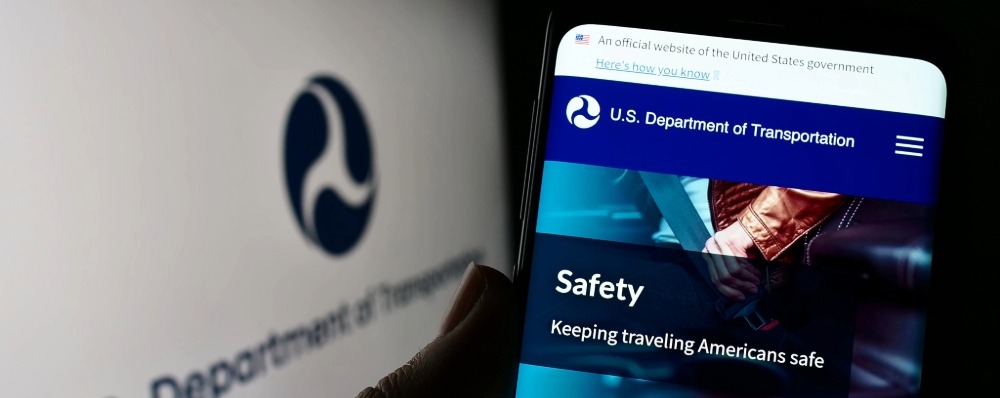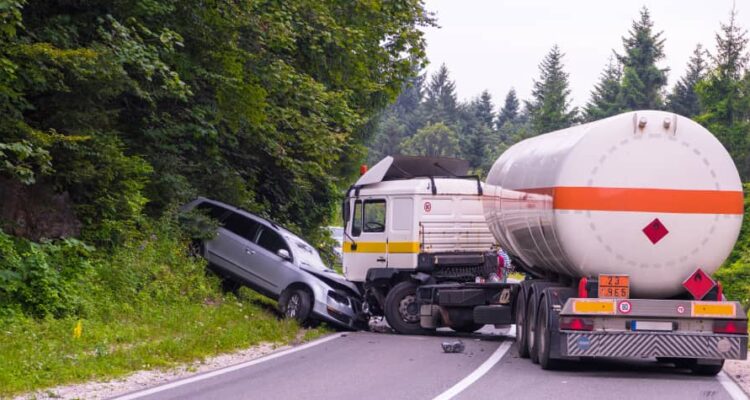Report to Congress Side Underride Protection Introduction Section 23011(c), “Side Underride Guards,” of the Bipartisan Infrastructure Law (BIL), enacted as the Infrastructure Investment and Jobs Act (IIJA), directs the Secretary to assess the use of side underride guards for trailers and semitrailers to mitigate vehicle underride crashes “in which a trailer or semitrailer intrudes into the passenger compartment of a passenger motor vehicle.”
This specific crash type is not the only type of truck crash that can cause death and serious injury. USDOT is committed to improving all aspects of truck safety as part of our commitment to reaching zero traffic fatalities.
In 2022, 5,936 people died in crashes involving large trucks (including trailers and semi-trailers), an increase of 2 percent from the previous year. This includes drivers of large trucks and their passengers (1,097) as well as people in other vehicles (4,839) and nonoccupants (672). While the point of impact for most fatal truck crashes is the front (67% in 2021) a subset of these fatalities result from passenger motor vehicle underride of the truck side or rear.
Because previous studies indicated that such underride crashes have been underreported, the National Highway Traffic Safety Administration (NHTSA) began its assessment by reviewing all police crash reports involving trucks in one year (2017). This report details NHTSA’s analysis of the extent of underreporting of vehicle underride in NHTSA’s fatal crash database and multiplication factors for estimating underride fatalities. Based on this analysis, NHTSA estimates that, on average, 89 fatalities annually fall within the scope of BIL’s directive: light passenger vehicle occupant fatalities in two-vehicle crashes with tractor-trailers where a light passenger vehicle strikes the side of a trailer or semi-trailer and underrides it.
Because NHTSA has also received comments expressing concerns about bicycle safety with respect to large trucks, it is also providing an update on its work to protect pedestrians and bicyclists in side crashes with large trucks. In 2021, 42 pedestrians and 17 bicyclists died in such crashes. These crashes do not fit the definition of “vehicle underride crashes,” but often result in similarly severe injuries, as these vulnerable road users fall under and are crushed by the wheels of the truck. Some jurisdictions, particularly in Europe, are installing “Lateral Protection Devices” (LPDs), which are generally lighter than the sideguards designed to stop vehicle underride. While this assessment does not focus on these devices, we are providing an update on NHTSA’s plans to conduct research on LPDs to address the safety of trucks when sharing the road with bicyclists, pedestrians, and other vulnerable road users.
Reducing non-occupant fatalities and injuries is a priority for NHTSA and the Department as a whole, as there has been a steep increase in these crashes over the last decade. A majority of these fatalities result from impact with the front of the vehicle (5,644) and NHTSA is addressing these crashes using a variety of tools including the recently finalized Light Vehicle Automatic Emergency Braking and Pedestrian Automatic Emergency Braking rule, the pending Heavy Vehicle Automatic Emergency Braking rule, and pending updates and improvements to the New Car Assessment Program. More broadly, the Department’s National Roadway Safety Strategy uses the Safe System approach to address all facets of risk, and USDOT’s other components, particularly the Federal Highway Administration and the Federal Motor Carrier Safety Administration, are also working to improve safety for everyone who uses the road.
NHTSA is taking several actions to address vehicle underride crashes beyond the scope of the assessment described in this report to Congress. First, NHTSA is committed to improving data collection to accurately identify side underride crashes, which are detailed in the “Agency Actions” section of this report.
NHTSA is also facilitating the Advisory Committee on Underride Protection (ACUP), which was formed to provide information, advice, and recommendations to the Secretary of Transportation on safety regulations to reduce underride crashes and resulting fatalities related to underride crashes. The recommendations of the Committee, as well as the assessment described below, will help determine the most appropriate next steps to advance commercial motor vehicle safety and reduce fatal underride crashes.
The agency, in cooperation with the Federal Motor Carrier Safety Administration, is taking other actions to address the difficult problem of truck crashes that result in fatalities and serious injuries. This report describes the assessment required by Congress and includes a summary of the methodology used, the benefit-cost analysis, and a review of the comments received. It ends with a summary of NHTSA’s future actions.
Scope of Assessment of Side Underride Guards
As described in the Introduction, Congress has directed the Secretary to assess the use of side underride guards for trailers and semitrailers to mitigate vehicle underride crashes.
Section 23011(c), “Side Underride Guards,” of the Bipartisan Infrastructure Law (BIL), enacted as the Infrastructure Investment and Jobs Act (IIJA), directs the Secretary to assess side underride guards for trailers and semitrailers to mitigate vehicle underride crashes, “in which a trailer or semitrailer intrudes into the passenger compartment of a passenger motor vehicle.”
Specifically, Section 23011(c)(1)(B) directs the Secretary to “assess the feasibility, benefits, and costs of, and any impacts on intermodal equipment, freight mobility (including port operations), and freight capacity associated with, installing side underride guards on newly manufactured trailers and semitrailers with a gross vehicle weight rating of 10,000 pounds or more.”
Section 23011(c)(3) of the BIL directs the Secretary to issue a notice in the Federal Register containing the findings of the assessment specified in Section 23011(c)(1)(B) and provide an opportunity for public comment.
Section 23011(c)(4) then directs the Secretary to submit to Congress a report that includes the results of the assessment specified in Section 23011(c)(1)(B), a summary of any comments received under Section 23011(c)(3), and a determination as to whether the Secretary intends to develop performance requirements for side underride guards.
NHTSA submits the following information regarding side underride guards for mitigating vehicle underride in impacts with the side of trailers and semitrailers in accordance with the reporting requirements in Section 23011(c)(4).
Assessment of Side Underride Guards for Trailers and Semitrailers
In April 2023, NHTSA published an assessment of the potential effects of a requirement for side underride guards on new trailers and semitrailers in a report titled “Side Impact Guards for Combination Truck Trailers: Cost-Benefit Analysis.” The report details analyses of crash databases for estimating annual fatalities and serious injuries in side underride crashes and the benefits and costs of requiring trailers and semitrailers to be equipped with side underride guards, pursuant to Section 23011(c)(1)(B) of the BIL and the National Traffic and Motor Vehicle Safety Act (Safety Act).
Previous studies have indicated that NHTSA’s crash databases underreport the occurrence of vehicle underride, which are collisions in which a car slides under the body of a larger vehicle. To obtain more accurate estimates of fatalities associated with side underride crashes, NHTSA considered the extent of underreporting of side underride crash fatalities through detailed examination of information on passenger vehicle crashes into the sides of trailers and semitrailers.
NHTSA conducted a detailed review of police crash reports (PCRs) and supplemental information on all 2-vehicle fatal crashes4 of light passenger vehicles into the side of truck trailers at all impact angles, including side-swipes, for the year 2017.5 This dataset is a census of all such crashes in the United States in 2017.6 NHTSA obtained and reviewed 184 PCRs of all relevant crashes in 2017 along with available supplemental information (e.g., photographs of the crash and vehicles involved, witness interviews). For some crash cases, NHTSA’s special crash investigations program conducted further review to determine whether vehicle underride occurred.
The agency conducted a technical review of each of the 184 crash cases to determine survivability factors (e.g., restraint status, occupant age, impact velocity), occurrence of underride, and passenger compartment intrusion resulting from underride. Based on this in depth study, NHTSA estimated that the number of side underride fatalities was about 80 percent higher than that reported in NHTSA’s current fatal crash databases. To account for this, a 1.8 multiplication factor was then applied to the average number of underride fatalities in 2-vehicle crashes for the 10-year period 2010-2019 to determine average annual underride crash fatalities.
NHTSA was aware of only one third-party-tested side underride guard, which was shown to mitigate underride in light vehicle crashes into the side of trailers up to 40 mph.7 Therefore, the target population of fatalities considered in the analysis includes all light vehicle occupant fatalities in front-to-side crashes with truck-trailers on roads with speed limits up to 40 mph that result in side underride events.8 The estimated target population, taking into account the underreporting, was estimated at 18 fatalities and 81 injuries.
With a 97 percent effectiveness in mitigating fatalities and 85 percent effectiveness in mitigating serious injuries in light vehicle crashes at speeds up to 40 mph, the agency estimates that side guards would save 17.2 lives (18 × 0.97 = 17.2) and prevent 69 serious injuries (81 × 0.85 = 68.85) annually if all trailers in the fleet are equipped with them.9 The discounted annual safety benefits when side underride guards are equipped on all applicable trailers and semitrailers are estimated to range from $129 million to $166 million at 3 and 7 percent discount rates. The total discounted annual cost (including lifetime fuel cost)10 of equipping new trailers and semitrailers with side underride guards is estimated to range between $970 million and $1.2 billion at 3 and 7 percent discount rates. The net benefits for a side underride guard requirement on trailers and semitrailers are estimated to be negative and in the range of -$1.038 billion to -$844 million.
NHTSA also conducted a sensitivity analysis to consider the effects of lower cost and weight of side underride guards, as well as the effects of a larger target population by assuming a higher level of underreporting such that the number of side underride fatalities are 2.55 times that currently reported in the fatal crash databases. The net benefits from this analysis were still negative (-$634 million to -$638 million).
The benefits estimates cited above do not account for the potential effects of advanced driver assistance systems such as automatic emergency braking, blind spot detection, and lane-keeping technologies, which could reduce the volume of potential side-underride crashes independently of the presence of side guards. The estimated cost impacts do not include additional costs that accrue due to incremental wear and tear on equipped trailers from nonuniform loading on the trailer floor due to the side underride guard structure, and interaction with road surface and on-road debris and loading docks. NHTSA’s analysis also did not take into consideration the practicability and feasibility of side underride guards on trailer and semitrailer operations and the effects of side underride guards on port and loading dock operations and intermodal operations. NHTSA did not have sufficient data to account for these effects on the benefits and costs estimates.
NHTSA’s analysis also did not take into consideration the practicability and feasibility of side underride guards on trailer and semitrailer operations and the effects of side underride guards on port and loading dock operations and intermodal operations. NHTSA did not have sufficient data to account for these effects on the benefits and costs estimates. NHTSA’s analysis also did not evaluate safety benefits of side underride guards protecting VRUs in collisions with large trucks or trailers because NHTSA does not have information indicating that the side underride guards evaluated in the analysis would mitigate VRU fatalities.
The analysis was focused on underride crashes (i.e., crashes involving a smaller vehicle impacting and sliding under the chassis of a larger vehicle) and side underride guards, which are intended to mitigate this type of crash. Therefore, NHTSA did not evaluate other crash types or measures intended to address those crashes, such as lateral protective devices (LPDs), which are intended to prevent injuries and fatalities resulting from VRUs being run over by a large truck or trailer’s wheels in side-impact collisions.
Federal Register Notice
NHTSA published an Advance Notice of Proposed Rulemaking (ANPRM), “Side Underride Guards,” in the Federal Register on April 21, 2023. The ANPRM summarized NHTSA’s report, titled “Side Impact Guards for Combination Truck Trailers: Cost-Benefit Analysis,” and requested public comment on the accuracy of the estimated benefits, costs, and other impacts of requiring side underride guards on heavy trailers and semitrailers. The ANPRM further requested comment on alternative solutions to mitigate or eliminate side underride crashes. The comment period for the ANPRM was scheduled to end on June 20, 2023. After receiving two requests to extend the comment period, NHTSA extended the comment period to July 20, 2023.
The agency received 2,072 comments on the ANPRM from April 22 to July 21, 2023. The vast majority (1,827 comments, or 88 percent) were from individuals expressing their support for comments submitted by the League of American Bicyclists, which requested that the agency account for VRU fatalities and serious injuries in determining the potential benefits of a side underride guard requirement.
Safety advocates were also critical of the agency’s estimates for side underride and the injury target population. They criticized the exclusion of higher travel speeds and different crash configurations in determining the potential benefits of side underride guards. Commenters stated that more accurate crash fatality data and in-house crash testing are needed for a more accurate assessment of side underride guards. Some comments suggested a federal weight allowance or cost subsidy for side underride guards due to the increased weight and cost. The trucking industry expressed concern about operational challenges and added costs of side underride guards, stating that many types of trailers could not accommodate guards and that the reduced ground clearance would be problematic on docks, railway crossings, and rough terrain. Intermodal associations detailed the reasons why side underride guards would be difficult to implement on intermodal chassis and would not be beneficial.
The ANPRM specifically addressed side underride guards on trailers for the protection of passenger vehicle occupants in the event of a collision, as specified in the BIL. Some commenters stated that side underride guards would also be able to protect VRUs. Others referred to existing requirements and Volpe Center recommendations for side guards, referring to LPDs. LPDs generally do not have the strength to prevent underride of passenger vehicles that side underride guards designed for that purpose would need.
Agency Actions
NHTSA is considering all available approaches to address underride crashes. NHTSA is working across modal administrations to ensure that the Department’s approach to safety is informed, effective, and reduces overall harm in collisions with large commercial vehicles. The Agency also continues to evaluate the effectiveness of side underride guards and their impact on intermodal equipment and operations, freight mobility, and freight capacity.
NHTSA has taken several steps to improve the accuracy of the data collected in its crash databases regarding underride. NHTSA released the 6th edition of the Model Minimum Uniform Crash Criteria (MMUCC) on January 4, 2024,13 which includes an underride/override element to increase the uniformity and accuracy of underride information in NHTSA’s crash databases. Additionally, NHTSA has distributed educational materials to State and local police departments on identifying and recording underride crashes and is providing enhanced training to coders/analysts for improved accuracy and quality control of data. NHTSA also recently completed a rulemaking that could help prevent and mitigate underride crashes and also improve safety for pedestrians. On May 9, 2024, the agency published a final rule14 requiring automatic emergency braking on passenger cars and light trucks, which could prevent underride crashes and fatalities. This final rule also includes requirements for automatic emergency braking on passenger cars and light trucks to mitigate pedestrian crashes. NHTSA is also evaluating crash avoidance and crashworthiness measures to improve safety for all those not traveling inside a vehicle, including bicyclists and motorcyclists.
NHTSA is facilitating the Advisory Committee on Underride Protection (ACUP), which is charged with providing information, advice, and recommendations to the Secretary of Transportation on safety regulations to reduce underride crashes and fatalities related to underride crashes. Members of the committee include safety advocates, family members of crash victims, and representatives of trailer manufacturers, truck operators, law enforcement, insurance industry, motor vehicle engineers, motor vehicle crash investigators, emergency medical service providers, and labor organizations.
Additionally, the Consolidated Appropriations Act, 2024 (Division F—Transportation, Housing and Urban Development and Related Appropriations Act, 2024, Publ. L. 118-42) and the associated Report No. 118-70,15 as incorporated by reference into the Joint Explanatory Statement, direct the Secretary of Transportation to conduct research on LPDs to address the safety of bicyclists, pedestrians, and other vulnerable road users. The Report also directs the Secretary to research societal co-benefits of LPDs on truck fuel consumption, enhanced driver visibility, and improved automatic emergency braking for detecting pedestrians and bicyclists. NHTSA intends to evaluate pedestrian and bicyclist safety in accordance with the Senate Report 118-70 and consistent with the actions identified in the NRSS.
Section 23011(c) directed the Secretary to determine whether NHTSA intends to develop performance requirements for side underride guards. Due to the nature of the ANPRM comments, and the role of recommendations from the ACUP in informing agency next steps, the Department has decided to defer determining whether to develop performance requirements for side underride guards until after receiving recommendations from the ACUP and completing an analysis of the comments received on the ANPRM. With regard to the prevention of side underride crashes involving pedestrians and bicyclists, a review of available approaches is underway at NHTSA to determine effective strategies, including LPDs. After these actions are complete, NHTSA will determine the most appropriate next steps.



